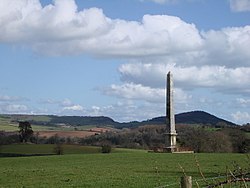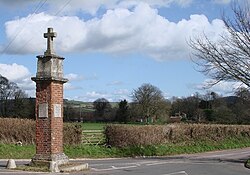Bicton, Devon
| Bicton | |
| Devon | |
|---|---|
 Church of St Mary, Bicton | |
| Location | |
| Grid reference: | SY070864 |
| Location: | 50°40’13"N, 3°19’1"W |
| Data | |
| Post town: | Budleigh Salterton |
| Postcode: | EX9 |
| Local Government | |
Bicton is a parish and former manor in Devon, in the south-east of the county, near the coastal town of Budleigh Salterton. The parish is surrounded, clockwise from the north, by the parishes of Colaton Raleigh, Otterton, East Budleigh and Woodbury.[1] According to the 2001 census it had a population of 280.
Much of the parish consists of Bicton Park, the historic home of the Rolle family,[2] once centred on Bicton House. Bicton Common lies adjacent to Woodbury Common, in the west. The parish includes the village of Yettington on its southern border.
History

Bicton appears in the Domesday Book of 1086 as Bechetone, held by William Porter, probably by the service of guarding the gate at Exeter Castle and the prison there.[3] An Act of Parliament in 1787 discharged the Rolle family from this obligation to keep the gate, by payment of a fine.
The manor passed through several families until Sir Thomas Denys (1559–1613) left two daughters as co-heiresses. The eldest was Anne Denys, who by her marriage to Sir Henry Rolle (d.1616) of Stevenstone, brought Bicton to the Rolle family.
When Mark Rolle died in 1907 he left no male heir so the Rolle inheritance passed to his nephew, Charles Hepburn-Stuart-Forbes-Trefusis, 21st Baron Clinton (1863–1957). The 21st Baron let and later sold the mansion house and surrounding lands to Devon County Council as an agricultural college, which became Bicton College, though retaining the greater part of the estate..
The gardens at Bicton were renovated by the baron in the 1950s and opened to the public in 1963. The 22nd Baron gave the botanical gardens to a charitable trust in 1986, which sold them in 1998 to Simon and Valerie Lister who turned their 63 acress into a commercial visitor attraction named Bicton Park Botanical Gardens. The remainder of the land comprising the former manor of Bicton is still owned by Baron Clinton under the management of Clinton Devon Estates. This includes 17,000 acres of tenant farmland, 4,700 acres of woodland and 2,800 acres of the East Devon Pebblebed Heaths. The equestrian venue known as Bicton Arena is also part of the estate.[4]
The gardens at Bicton were renovated by Lord Clinton in the 1950s and opened to the public in 1963. The 22nd Baron gave the botanical gardens to a charitable trust in 1986, which sold them in 1998 to Simon and Valerie Lister who turned their 63 acress into a commercial visitor attraction named Bicton Park Botanical Gardens. The remainder of the land comprising the former manor of Bicton is still owned by Baron Clinton under the management of Clinton Devon Estates. This includes 17,000 acres of tenant farmland, 4,700 acres of woodland and 2,800 acres of the East Devon Pebblebed Heaths. The equestrian venue known as Bicton Arena is also part of the estate.[5]

Church
In 1850, Lady Louisa Rolle commemorated her late husband by building a new church on the estate close to the old one, which was partly demolished and the chancel reworked by Augustus Pugin as a mausoleum to the Rolle family. The mausoleum, which is not open to the public, contains Minton floor tiles, a vaulted ceiling, east and west decorated windows by Pugin, and a Rolle monument on the north wall designed by George Myers.[6] It also contains the baroque marble tomb of Denys Rolle (died 1638) and his wife and son, which was described by W. G. Hoskins as "magnificent".[7] Some fifty years before its demolition, the topographer John Swete made a watercolour painting of the old church, and wrote of its picturesque setting in his journal in 1795.[8]
The church of 1850 was designed by the Exeter-based architect, John Hayward: Hoskins simply called it "dull",[7] though it was later described as an early example in Devon of the ideals of the Cambridge Camden Society.[6]
Landmarks


The Bicton Obelisk on the edge of the park was built in 1747 by Henry Rolle, 1st Baron Rolle (1708–1750) as a visual attraction for the gardens.[6]
Rolle also built in 1743 the four-sided pillar in the centre of the four-cross-ways between Bicton and Otterton, both parishes in his ownership. As well as serving as a signpost for the various places to which the four roads lead, it incorporates biblical inscriptions, such as "Her ways are ways of pleasantness", etc.[8]

Bicton Park Botanical Gardens
Bicton Park Botanical Gardens is a tourist attraction on the southern part of the former Bicton estate. The landscaped park includes historic glasshouses, a countryside museum, the Bicton Woodland Railway train ride, nature trail, maze, mini golf, indoor and outdoor children's play complexes, restaurant and shop. The gardens, which originated in c.1730 are Grade I listed.
The four glasshouses at Bicton Gardens were designed to re-create the natural environment of plants from different continents. The Palm House was built in the 1820s to a curvilinear design, using 18,000 small glass panes in thin iron glazing bars. The Tropical House is the home of the Bicton orchid (Lemboglossum bictoniense), named after the Park where it first bloomed in 1836. The Arid House features cacti and other succulents growing in a naturalistic desert landscape.
Outside links
| ("Wikimedia Commons" has material about Bicton, Devon) |
References
- ↑ "Map of Devon Parishes". Devon County Council. http://www.devon.gov.uk/devon_districts_2002_.pdf. Retrieved 20 June 2013.
- ↑ Harris, Helen (2004). A Handbook of Devon Parishes. Tiverton: Halsgrove. p. 19. ISBN 1-84114-314-6.
- ↑ Thorn, Caroline & Frank, (eds.) Domesday Book, (Morris, John, gen.ed.) Vol. 9, Devon, Parts 1 & 2, Phillimore Press, Chichester, 1985, part 2, 51:1.
- ↑ [http://www.clintondevon.com/_assets/pdf/resources/cde%20infographic.pdf Clinton Devon Estates Infographic]
- ↑ [http://www.clintondevon.com/_assets/pdf/resources/cde%20infographic.pdf Clinton Devon Estates Infographic]
- ↑ 6.0 6.1 6.2 Nikolaus Pevsner: The Buildings of England: Devon, 1952; 1989 Penguin Books ISBN 978-0-300-09596-8
- ↑ 7.0 7.1 Hoskins, W. G. (1972). A New Survey of England: Devon (New ed.). London: Collins. p. 335. ISBN 0-7153-5577-5.
- ↑ 8.0 8.1 Gray, Todd & Rowe, Margery (Eds.), Travels in Georgian Devon: The Illustrated Journals of The Reverend John Swete, 1789–1800, 4 vols., Tiverton, 1999, vol.2, pp.140–145